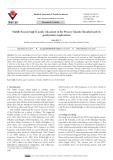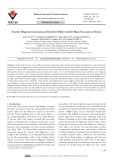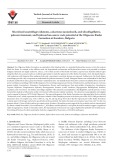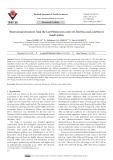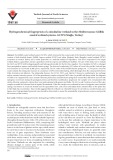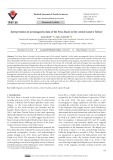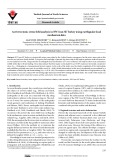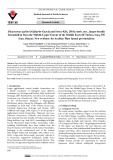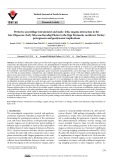
Journal of Earth Sciences
-
Lithostratigraphic units (formation, strata, and beds) and regional stages of the Oligocene-lower Miocene succession of southern Ukraine are described based on the results of comprehensive lithological and paleontological data analysis. The historical perspective on the stratigraphical investigations of the Maikop Group in the Crimean and Kerch Peninsulas and their equivalents in the broader Peri-Black Sea Region were also integrated in this overview.
 38p
38p  tanmocphong
tanmocphong
 29-01-2022
29-01-2022
 14
14
 2
2
 Download
Download
-
They show high-K calc-alkaline affinity. On primitive-normalized spider diagrams, negative anomalies of Ba, Nb, Sr, P, and Ti and positive anomalies of Pb are noteworthy. Their chondrite-normalized REE patterns are characterized by strongly fractionated patterns with demonstrative negative Eu anomaly, whereby middle REE are not fractionated relative to the heavy REE. These geochemical features suggest a fractionating mineral assemblage of feldspar, apatite, and biotite without significant involvement of garnet.
 12p
12p  tanmocphong
tanmocphong
 29-01-2022
29-01-2022
 11
11
 2
2
 Download
Download
-
A belt of Upper Eocene–Lower Oligocene marine sedimentary rocks extends from Kıyıköy on the Black Sea coast to Pınarhisar in the Thrace Basin, suggesting a marine connection between the Black Sea and the Thrace Basin during this period. The Cenozoic succession of this marine corridor was studied in the vicinity of Kıyıköy along two measured stratigraphic sections.
 15p
15p  tanmocphong
tanmocphong
 29-01-2022
29-01-2022
 12
12
 1
1
 Download
Download
-
The Oligocene Ruslar Formation, an equivalent of the Maykop Suite, is a potential hydrocarbon source rock in the western Black Sea Basin. In contrast to the offshore areas, the depositional environment and hydrocarbon source rock potential of onshore Bulgaria sediments are largely unknown. Hence, a 14-m-thick section of the Ruslar Formation, exposed near Karadere (Black Cape) along the Black Sea coast, provides an excellent opportunity to study the upper part of the Ruslar Formation.
 21p
21p  tanmocphong
tanmocphong
 29-01-2022
29-01-2022
 12
12
 1
1
 Download
Download
-
North of İstanbul, the thick Upper Cretaceous volcanic and volcanoclastic sequence of the Yemişliçay Group is nonconformably overlain by the neritic clastic and carbonate sequence of the Zekeriyaköy Formation. This unit, either placed within the volcanic sequence or interpreted to overlie it, was studied near Zekeriyaköy for its larger foraminifera, previously recurrently referred to as the Maastrichtian. The basal epiclastic sandstone beds of the Zekeriyaköy Formation immediately above the volcanic sequence contain Praesiderolites dordoniensis and rare rudist shells.
 21p
21p  tanmocphong
tanmocphong
 29-01-2022
29-01-2022
 14
14
 1
1
 Download
Download
-
Herein, 20 ichnospecies belonging to 8 ichnogenera were identified in bivalves, gastropods, and corals (n = 701) from the Late Pleistocene coral reef along the Red Sea coast, northwest Saudi Arabia. The trace fossils were produced by clionid sponges (47.39%), endolithic bivalves (42.17%), polychaete annelids (5.42%), vermetid gastropods (3.81%), and acrothoracican barnacles (1.21%). The habitat conditions changed gradually, from well-oxygenated, shallow, high-energy back-reef and reef crest bioeroding polychaetes and bivalves, to deep, low-energy reef slope dominated by boring sponges.
 16p
16p  tanmocphong
tanmocphong
 29-01-2022
29-01-2022
 10
10
 1
1
 Download
Download
-
In parallel with these results, the diagrams of Gibbs et al. supported the same seawater intrusion phenomena. Brackish karst springs first roseand then fell below sea level with epirogenic movements during the geological period, and therefore, karstification progressed. The samples were oversaturated with calcite, dolomite, and quartz, whereas they were undersaturated with gypsum and halite. The Al, Cu, and Zn values of some of the water samples exceeded the tolerance limit of aquatic life standards.
 21p
21p  tanmocphong
tanmocphong
 29-01-2022
29-01-2022
 10
10
 1
1
 Download
Download
-
The Kösdağ Metavolcanics (KMs) in the southern Central Pontides are exposed between the İzmir-Ankara-Erzincan Suture Belt in the south and the Sakarya Composite Terrane in the north. They comprise an approximately 40-km-long tectonic unit, bounded by the splays of the North Anatolian Transform Fault in the north and the Kızılca Thrust in the south. The basement of the unit mainly consists of metabasalts, metaandesites, and metarhyolites, with well-developed blastomylonitic textures, which are interlayered by recrystallized pelagic limestone and chert.
 22p
22p  tanmocphong
tanmocphong
 29-01-2022
29-01-2022
 16
16
 1
1
 Download
Download
-
The Sivas Basin is located in the eastern part of the central Anatolia. In this study, aeromagnetic data in the basin and surrounding area are processed and anomalies are interpreted to determine the approximate locations of the causative bodies and reveal their relationship with the tectonic trends. The sedimentary basin is surrounded by strong magnetic anomalies from the south, east, and northeast. The most apparent anomalies are observed in the E-NE of Zara, SW of Divriği, and north of Kangal.
 12p
12p  tanmocphong
tanmocphong
 29-01-2022
29-01-2022
 16
16
 1
1
 Download
Download
-
The Late Pleistocene-Holocene evolution of the Adapazarı Basin was investigated using the stratigraphy, geometry, and absoluteluminescence dating of the 4-step fluvial terrace staircases of the Sakarya River. The results revealed that the fluvial cycle was primarily related to relative sea level changes of the Black Sea. The initiation of deposition and the abandonment ages of the terraces indicated relative high stands during marine isotope stage (MIS) 5a (~84–72 ka), 3 (40–30 ka), and 1 (9 ka-recent).
 23p
23p  tanmocphong
tanmocphong
 29-01-2022
29-01-2022
 15
15
 1
1
 Download
Download
-
The Payas region bauxite deposits occur as a sandwiched layer that is a few kilometers long and an average of 10 m thick between the lower and upper Cretaceous carbonates of the Arabian Platform. The bauxites occur as 2 types, comprising blanket and pocket, are chemically and texturally homogeneous, and have a thrust structure with ophiolitic mélange formations. The bauxite varies in color, from reddish-brown to grayish-green to black, and has a massive, patchy, and very rare oolitic-pisolitic texture.
 26p
26p  tanmocphong
tanmocphong
 29-01-2022
29-01-2022
 21
21
 1
1
 Download
Download
-
Herein, a combined analysis of Global Navigation Satellite System-derived strain rate maps, in accordance with recent seismicity, was presented to reveal that the N-S extension is accommodated primarily by strike-slip faulting of the İzmir-Balıkesir Transfer Zone (İBTZ), where a counter clockwise rotation (~25–100°/Myr) along the vertical axis is dominant. The results indicated that strike-slip segments within the İBTZ show variable transport sense and amount of slip along them, and they connect by hard linkage relay ramps with the dip to oblique slip normal faults.
 18p
18p  tanmocphong
tanmocphong
 29-01-2022
29-01-2022
 19
19
 1
1
 Download
Download
-
The southern part of the Western Anatolia Extensional Province is governed by E-W-trending horst-graben systems and NW-SE-oriented active faults. The NW-striking Yatağan Fault is characterised by an almost pure normal sense of motion with a minor dextral strike slip component. Although the settlements within the area have been affected by several earthquake events since ancient times (~2000 BCE), the earthquake potential and history of the Yatağan Fault has remained unknown until a few years ago.
 21p
21p  tanmocphong
tanmocphong
 29-01-2022
29-01-2022
 14
14
 1
1
 Download
Download
-
In this study seasonal changes in the geochemical and stable isotope compositions of Hisaralan thermal waters in Simav Graben, western Turkey, were investigated with regards to a variety of mineral-water interactions and mixing processes. The Hisaralan and Emendere geothermal waters, with temperatures of up to 99 °C, were mostly of Na-HCO3 and Ca-HCO3 types. The δ18O and δ2 H values of the Hisaralan waters ranged from –9.32‰ to –8.73‰ and –65.02‰ to –61.10‰, with maximum seasonal differences of 0.3‰ and 1.8‰. The Emendere waters were represented by a more positive range of δ2 H values (–54.
 22p
22p  tanmocphong
tanmocphong
 29-01-2022
29-01-2022
 13
13
 1
1
 Download
Download
-
Large earthquakes that have occurred along the North Anatolian Fault (NAF) were analysed to elaborate the time frame of future large earthquakes near İstanbul. The historical earthquake catalog that was compiled covered 1 nearly complete and 2 fully complete failures of the NAF between 1250 and 2000 AD. These data were used to investigate the space-time systematics of M ≥ 7.0 earthquakes. The catalogue identified an east-to-west decelerating domino-like failure of the NAF. The deceleration starts around the western tip of the 1944 Gerede rupture.
 11p
11p  tanmocphong
tanmocphong
 29-01-2022
29-01-2022
 12
12
 1
1
 Download
Download
-
We have investigated the time-dependent seismicity model of the earthquake occurrence on a regional basis through the North Anatolian Fault Zone (NAFZ). To that end, the studied region has been subdivided into 7 seismogenic zones considering the seismotectonic criteria, and then regional time and magnitude predictable (RTIMAP) model has been performed. Intervened times and magnitudes of main shocks produced in each zone have predictive properties defined by the RTIMAP.
 20p
20p  tanmocphong
tanmocphong
 29-01-2022
29-01-2022
 30
30
 1
1
 Download
Download
-
NW Iran-SE Turkey is a tectonically active zone related to the Arabia-Eurasia convergence, but the active stress state in this zone has not yet been clearly studied. To improve the knowledge of present-day stress state in this region, optimum reduced stress tensor was analysed. For this, a large number of earthquake focal mechanisms (277) were collected. The analyses show most mechanisms exhibit strike-slip to thrust faulting. These data indicate that this region is dominated by an N158° maximum horizontal compressive stress (SHmax) belonging to a transpressional tectonic regime.
 21p
21p  tanmocphong
tanmocphong
 29-01-2022
29-01-2022
 40
40
 1
1
 Download
Download
-
Analysis of ca. 1400 km of multichannel seismic data indicate that the distal part of the Sakarya Canyon within the continental rise is an unstable region with sediment erosion. Fourteen buried debris flows (DB1–DB14), in the stacked form within Plio–Quaternary sediments between 1400 and 1950 m water depth, were observed in the surveyed area. Their run-out distances range from 3.8 to 24.4 km. The largest debris flow DB10 affects ca. 225 km2 surficial area transporting ca. 15 km3 of sediment in S to N direction.
 21p
21p  tanmocphong
tanmocphong
 29-01-2022
29-01-2022
 9
9
 1
1
 Download
Download
-
Rogerella aydimi Gallardo-Garcia and Serra-Kiel was described from the Priabonian Haluf Member of the Aydim Formation, Oman. Based on new finds from the Bartonian Hoya Formation of SE Turkey and the Jahrum Formation of Iran, its taxonomic status is discussed herein. It is concluded that it represents a species of Dictyoconus with a simple subepidermal network (1 rafter, 1 intercalary beam) below a thin epiderm. The stratigraphic range of D. aydimi known thus far is Bartonian-Priabonian or Shallow Benthic Zone 17– 20. The distribution of D.
 11p
11p  tanmocphong
tanmocphong
 29-01-2022
29-01-2022
 16
16
 1
1
 Download
Download
-
The Hellenic subduction system governs the entire Aegean region through the creation of a migrating magmatic arc that has existed since the beginning of the Early Cenozoic. The Karadağ Pluton is situated in the NW part of Turkey and represents one of the distinct snapshots of this subduction system during the Late Oligocene-Early Miocene Period.iod. It consists of 2 major lithological units, based on their petrographic and geochemical features, comprising: 1) main plutonic facies (SiO2 < 70 wt.
 34p
34p  tanmocphong
tanmocphong
 29-01-2022
29-01-2022
 13
13
 1
1
 Download
Download
CHỦ ĐỀ BẠN MUỐN TÌM









